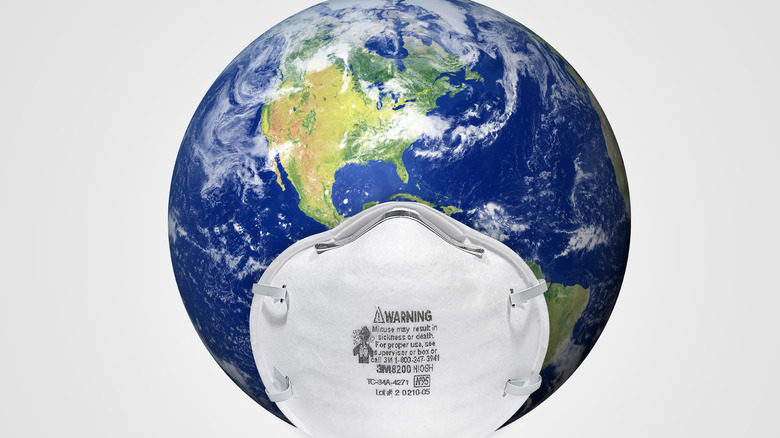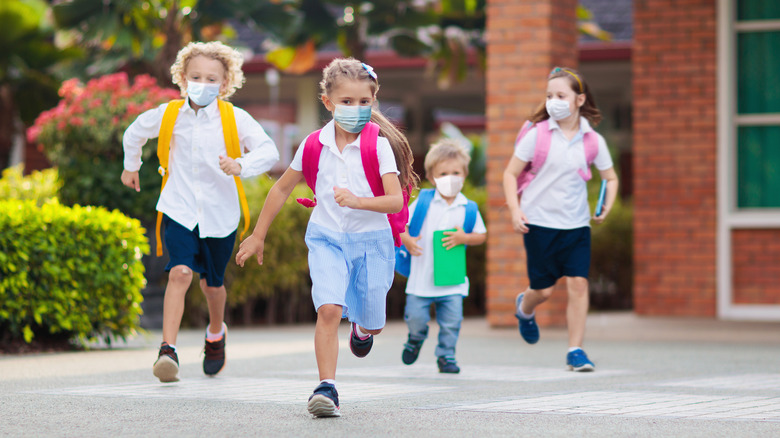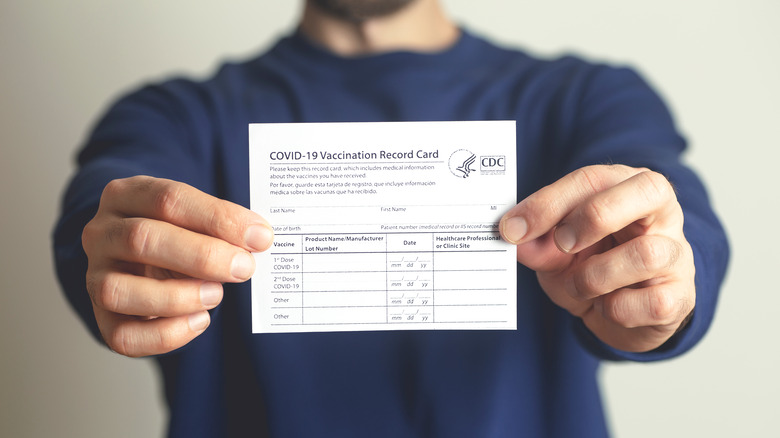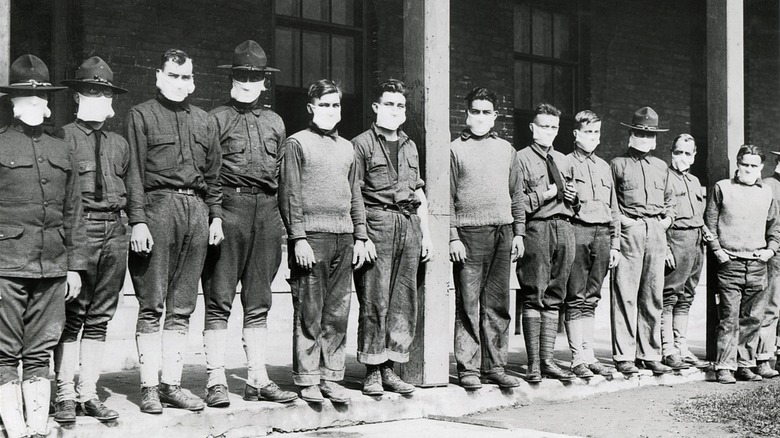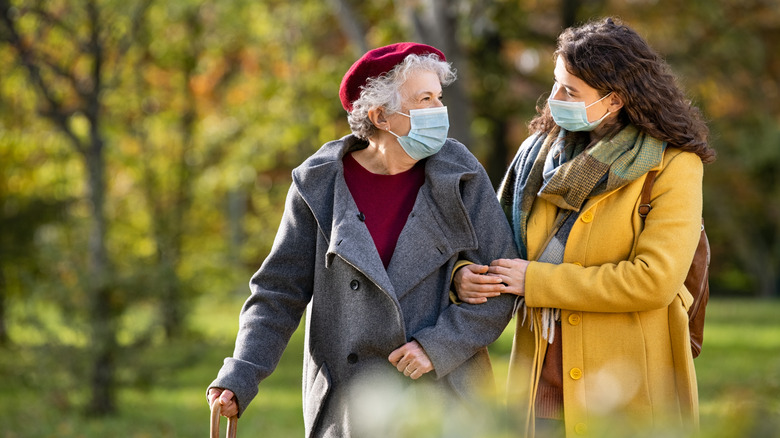When Will The Coronavirus Pandemic End? Here's Everything We Know
Most people would agree that it's hard to believe the coronavirus pandemic has been going on as long as it has. Although a few might have expected this once-in-a-lifetime health crisis to continue affecting everyday life for more than two years, many of us thought it would be over in two weeks when safety measures were encouraged and stay-at-home orders were enforced back in March 2020 (via NBC News).
Throughout the months and years that have followed, scientists and health experts have made advances toward understanding COVID-19 so it can be properly avoided and treated. Vaccines have been available for more than a year, but still COVID-19 continues to be a problem that leaves many people wondering, "When is all of this going to be over?"
The unfortunate reality is that nobody really knows for sure what the future will bring; however, scientists and health experts have enough understanding at this point to make fairly reliable predictions. Here's what we know so far....
We will likely never see COVID-19 go away completely
What does the end of a pandemic look like? If you're somebody who imagines that we'll one day be back to a world where the novel coronavirus that causes COVID-19 no longer exists, then there's some bad new you need to hear: We probably will never see a complete elimination of this coronavirus, CNN reports.
Yes, there have been some pandemics that have come to an end because the virus dies out, but in the case of COVID-19, we're more likely to see the virus become much less of a threat than it has been during the past two years. When this happens, the outbreak will no longer be a pandemic and will transition to being an endemic. And although this might not sound as great as the ideal situation of completely eliminating the virus, CNN reported that this was a possibility the World Health Organization (WHO) foresaw even in the early days of the pandemic.
There are several key indicators of an endemic versus a pandemic
With so much coverage surrounding COVID-19's global outbreak, most people understand what constitutes a pandemic: A disease that is impacting substantial numbers of people across multiple countries or continents (via Centers for Disease Control and Prevention). But what exactly is an endemic, and how will we know when the COVID-19 crisis has made the step down to endemic status?
An endemic is where a disease persists, but not on an all-threatening global scale. Instead, it might spread throughout some populations in some countries at some times of the year. This means it's much more manageable, so life can (for the most part) carry on as normal (via Vox).
Endemicity is a relatively loose concept, however, because not everyone's idea of "manageable" is quite the same. By definition, an endemic looks like one infected person spreading the virus to only one other infected person rather than multiple people. But health experts and governments also must determine that hospitalizations, deaths, and access to medical care are not out of control. When that happens, COVID-19 will no longer be considered a pandemic and will move to endemic status.
More people are feeling hopeful about the course of the pandemic in 2022
Not that public opinion has much to do with the way the pandemic comes to an end, but it does look as if people are feeling good about the way things are headed, at least according to a poll conducted by USA Today at the beginning of January 2022. Based on responses from the 1,000 people surveyed by phone (landline and cell) during the last few days of 2021, there's a general feeling of optimism. As many as 46% of respondents said that they were hopeful; however, there was a significant portion of respondents who said they were worried (19%) or just plain exhausted (18%).
Still, this outlook is a sharp contrast to the way people feel about 2021. About 80% of respondents had negative words to sum up the year — that it was terrible, that it was chaos, that it was challenging, or even a train wreck. It sounds as if most people are ready to leave the pandemic behind and hope for life to move in a new direction. But there are other opinions that might hold a little more weight than that of the average citizen....
Even health officials are feeling optimistic, including those at WHO
It's one thing for the layman to have hope; it's much more significant when the experts have hope. And that's what we're seeing here with the coronavirus pandemic. The director general of the World Health Organization, Tedros Adhanom Ghebreyesus, posted on LinkedIn at the end of December 2021, stating that 2022 could very well mark the end (or at least, the beginning of the end) of the COVID-19 pandemic.
What's his reasoning for that? Primarily, he explains, it's because health experts (and the general public) now have a much better understanding of the virus than they did during 2020 or even during 2021. He emphasizes that such healthy practices as mask wearing, physical distancing, improved ventilation, testing, and contract tracing are understood to be the ways of controlling transmission. Add to this the potential of vaccines to boost immunity and reduce severity of symptoms, and the world is in a good position to overcome the pandemic.
But experts say inequity around the world will prolong the pandemic
Even though Tedros Adhanom Ghebreyesus, director general of the WHO, says we have the power to beat the pandemic, that doesn't meant there aren't significant challenges in our way, according to reporting by CNN. The biggest one? Inequity around the world. A pandemic is an outbreak that occurs globally, and even if wealthy countries have access to all the resources that they need to keep their population healthy, a disease remains a serious threat when poorer countries don't have that same access.
In the case of this pandemic, populations in wealthy countries like the United States are fully vaccinated and boosted. But in poorer countries like many in Africa, even health care workers might be unvaccinated. When there is inequity like this around the world, it creates more potential for the virus to mutate. This is why the WHO is making it a priority by the middle of 2022 to create programs that will provide vaccinations all over the world and get the immunization rate to 70% in every country.
Variants can unexpectedly change the course of the pandemic
Let's talk about those mutations and variations of the virus. Why is it such a concern that the virus could mutate? Well, when a virus mutates, it's not exactly clear whether the mutation (also known as the variant) will behave the same way as the original strain of the virus or the earlier variants (via CNN). This means it could be more contagious, it could cause more severe symptoms, or it could even infect people who were immune to past strains.
Take a look at the Delta and Omicron variants of the coronavirus. These new strains emerged after the virus had spread throughout significant portions of the population. And unfortunately, because they act differently, that means they will change the way the virus continues to spread and the ways it can be contained. As long as a virus has the chance to mutate, it can be difficult to figure out how to bring a pandemic to an end.
Health and safety guidelines are changing
When people ask, "When will the COVID-19 pandemic be over?" what they're often asking is, "When will life go back to normal?" It's an understandable question — and it's why it's such a significant move when health experts change their health and safety guidelines, such as the Centers for Disease Control and Prevention (CDC) did in late December 2021 regarding isolation and quarantining.
The CDC explains that these changes were made based on the most up-to-date knowledge its members have about COVID-19 and the Omicron variant. As of December 27, 2021, people with COVID-19 who are asymptomatic should isolate for five days instead of the previously recommended 10 days. However, those individuals should still wear a mask for the five days following their isolation period to minimize risk of transmission to others. These rules also apply to people with COVID-19 whose symptoms have resolved.
Why the change? Per the CDC's statement, the science shows transmission is most likely to happen during this initial five-day period. Because of these new guidelines, the impact of COVID-19 positivity has a lessened impact of the infected person's ability to get back to daily life while still keeping others around them safe.
The Omicron variant has been different from other strains
Remember that when the virus mutates, the new strain of the virus can be unpredictable (via CNN). And a perfect example of that is the Omicron variant that has quickly become dominant among COVID-19 cases (and is all the buzz in health-related news at the beginning of 2022). This is one of the reasons that infections are at an all-time high. Omicron is much more contagious — and it's spreading through populations at a much higher rate.
Still, there is some good news. The Omicron variant causes symptoms that are much less severe. Still, this is not a reason for anyone to abandon caution, as Dr. Anthony Fauci, director or the National Institutes of Allergy and Infectious Disease, tells CNN. That's because even if cases are milder, the sheer number of them could be enough to overwhelm hospitals.
Additionally, as CNN reports, the spread of Omicron is affecting other aspects of society beyond health care — it is forcing businesses and schools to shut down. These closures have a major impact on the economy.
The latest wave is affecting children like never before
The other twist that the Omicron variant has brought to the pandemic is the way it affects children. The Associated Press reports that a record number of children have been hospitalized during this wave — something that's especially alarming given that previous strains of the coronavirus appeared to have less of an effect on children compared with adult populations. During the last full week of December 2021, the number of children hospitalized was up by 66%.
Still, doctors note that infections requiring hospitalization are primarily seen in unvaccinated children, even though many of the patients are of an age where they are eligible to be vaccinated. By contrast, children who are vaccinated — even children with other health complications — do not have as hard a time battling a coronavirus infection.
The cases not only put a strain on the health care system, but also mean that the parents and guardians who are around a sick child are also at risk of serious illness.
It's going to take about 80-90% immunity to overcome the pandemic
Containing a pandemic and bringing it down to an endemic level is about controlling the spread — and one of the best ways to do that is through vaccinations, as CNN explains. Immunity among a population means a virus doesn't have a chance to infect large numbers of people and doesn't have a chance to mutate.
As of the end of December 2022, according to CNN, the United States was seeing about a 62% vaccination rate, which is far too low to contain the spread of the virus, particularly taking into consideration the fact that an even smaller percentage of the population has received a third dose of the vaccine, commonly referred to as the booster. If the U.S. wants to contain the virus, it's going to need to see immunization levels of about 80-90%. For comparison, measles was not under control in the U.S. until about 95% of the population had immunity to it.
The problem is that the Omicron variant appears to affect even people who are vaccinated
Here's where it gets tricky when it comes to the Omicron variant (and maybe even future variants): According to studies, omicron is affecting even vaccinated individuals (via Reuters). Specifically, omicron is about 2.7 to 3.7 times more contagious than the Delta variant, which was the biggest variant of concern before Omicron.
Why is this? Well, as Reuters explains, a virus could become more transmissible because it lingers in the air for a longer amount of time or because it has an increased ability to latch onto cells. In some cases, it might just be that a variant of a virus is better at not being fought off by a body's immune system. At this point, it seems as if it's this third reason — the virus's ability to evade the immune system, even immune systems bolstered by vaccinations — that explains why Omicron is so pervasive.
We still need to adhere to safety precautions, especially during the wave of this new variant
As our society made progress in fighting the pandemic throughout 2020 and 2021, restrictions were relaxed and people started to feel more comfortable returning to regular activities. Vox reports that this was the experience of Bob Wachter, who chairs the University of California San Francisco's department of medicine. In the beginning of the pandemic, he adhered to strict health and safety guidelines, but as time went on, he started going to restaurants and conferences.
Now that the Omicron variant has emerged and proven to be more easily transmissible that other strains, sending numbers of infections and hospitalizations back up again, populations can't afford to be as lax as they were about health and safety guidelines. Vox notes that health experts recognize the serious detriments that come with strict lockdowns, such as those that governments imposed in March 2020. Therefore they are not recommending those measures this time around. Instead, avoiding high-risk activities like large indoor gatherings will go a long way in preventing the spread of the coronavirus, at least until this most recent wave has passed.
For a better idea, it helps to look at history
One of the reasons it's so hard to predict when the coronavirus pandemic will end is that there's no one-size-fits-all ending to a pandemic, as the Los Angeles Times highlights. It can be especially discouraging when society was poised to make so much progress toward eradicating COVID-19 when vaccines became widely available in the earlier half of 2021, and in 2022 the pandemic is still going on, with infection numbers higher than ever before. Where does it go from here?
The Los Angeles Times points to past pandemics as examples of what endings we can eventually hope for. Take the polio pandemic, which reached its height in the 1940s. It was eventually reined in when a vaccine because available in the 1950s and the U.S. united to get vaccinated and eradicate the virus. As of the 1970s, the United States is free of polio. Similarly, the smallpox pandemic was also eradicated by vaccine, not only in the U.S. but also around the whole world. Although not eradicated by vaccines, SARS and Ebola were contained by public health measures that limited and ultimately ended their spread.
That said, these situations are unlikely to happen with the coronavirus — instead, health experts believe that vaccines, testing, and treatment will progress to the point that living with the virus without straining health care systems will be come much easier.
A post-pandemic world will likely be different based on a person's risk
At this point, it's inevitable the world will never be free from COVID-19 the way it was back in 2019, as Syracuse.com points out. But when enough countries around the globe have enough control over containing the spread and treating infections, it will be up to the World Health Organization to state that we are no longer living in a pandemic.
At that point, the disease will continue to be endemic, and societies will find a way to live with it in a non-disruptive way. An individual's level of normalcy will greatly depend on that person's level of risk, which will be determined not only by their general health but also by their immunity, either from a prior case of COVID-19 or from vaccination. For a healthy individual who has been vaccinated, a case of COVID-19 might look like a bad cold. They take the medicine they need to fight it, deal with the symptoms for a few days, isolate themselves from others to avoid spreading the sickness, and then move on with life a few days later. But neither the United States nor the rest of the world is at that point — and it's not yet 100% clear when we will be.






